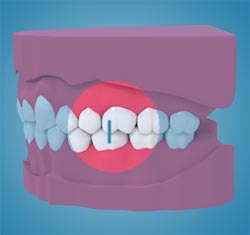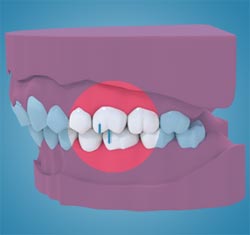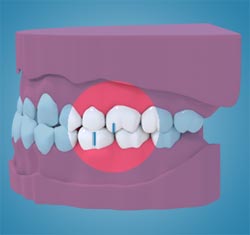Oblong bite disorders
There are many different classifications, segregated bite defects occurring in humans. One of the basic ways to rank tooth setting disorders is to qualify bite defects into one of the three classes by. Angle'a. According to the above classification, the first upper shanks (top sixes) should be slightly behind from the lower first shanks (lower sixes). The upper and lower teeth should be positioned so that they can take on each other on the principle of intertwined fingers of both hands or zipper. According to angle classification, we distinguish 3 classes of irregularities:
- Orthodontic Class I according to Angle – occurs when the relationship between the molars is correct, i.e. the lower six is in front of the upper six in such a way that the first nodule of the upper tooth with its apex aims at the furrow located in the middle of the lower tooth. Defects in this group mostly apply to the anterior segment and these are usually – stamping, tilting and rotation of teeth. Read more about the disorders in this group of patients…
- Orthodontic Class II according to Angle – characterized by the retraction of the lower six relative to the top six. As a result of this setting of the stem teeth, there is a jump of one lump of the insane of the upper and lower teeth. As the teeth during development seek mutual contact, the lower teeth are elongated, and the upper teeth tilt, causing a stamping and unsightly appearance. There are two subgroups of this class:
- Group I – incisors are tilted outside
- Group II – incisors are tilted inside
- Orthodontic Class III according to Angle – occurs when the lower six is in front of the top six by one more nodule than in the case of class I
The severity of the defect is evidenced by the distance between the upper and lower stem shanks in the horizontal plane. If the relationship between the upper and lower stems is disturbed to a small extent, then the determination of the nodule class is often used, because as a result of such a position, the teeth are set to the lump.
Faqs:
- Does the type of defect affect the duration of orthodontic treatment? Yes, the duration of orthodontic treatment directly depends on the severity of the defect. From a practical point of view, each patient has a different dental defect, therefore, each patient will have an individual treatment plan. Despite this variability, it takes 18 to 24 months to set the teeth correctly in most patients.
- My defect is not on the list, and yet I do not have simple teeth. The above description shows the possible settings of teeth according to the Angle classification, which refers to the horizontal plane of the teeth – the so-called posterior and anterior defects. Although this classification describes the situation of most patients well, it requires a certain skill. The correct orthodontic diagnosis should always be made by the doctor planning treatment.

Class I by Angle'a

Class II acc. Angle type two

Class III acc. Angle'a
 Class I by Angle'a
Class I by Angle'a  Class II acc. Angle type two
Class II acc. Angle type two  Class III acc. Angle'a
Class III acc. Angle'a